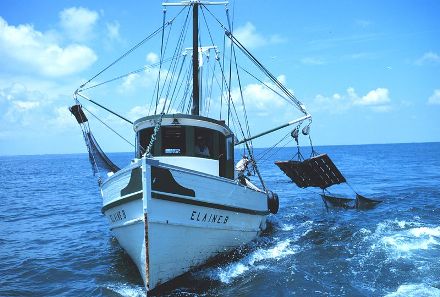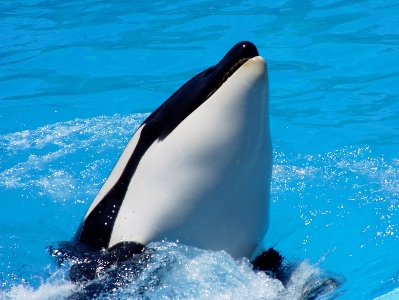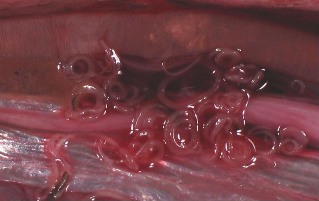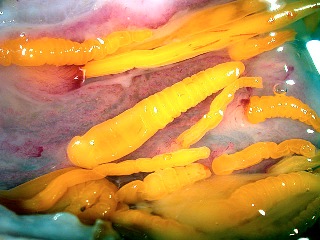King of the Pacific... Almost
 In most marine ecosystems, the
halibut is close to the top of the food chain. Its only known predators in the northern Pacific are the
orca whale (pictured
lower left),
the sea lion
(pictured upper left), and the salmon shark, a close relative to
the
great white shark.
Surprisingly, one of its greatest
threats is the sand flea (pictured below). Sand fleas
are parasitic crustaceans that live in the North Pacific.
They infect a wide variety of fish and whales by digging
into the skin or under the scales, and eating their host. After consuming the slime coating and outer-most layer of
epidermis, during which time the halibut will remain alive, the
crustaceans will migrate into its host through the eyes or the
anus. At this point
there is little chance for survival.
In most marine ecosystems, the
halibut is close to the top of the food chain. Its only known predators in the northern Pacific are the
orca whale (pictured
lower left),
the sea lion
(pictured upper left), and the salmon shark, a close relative to
the
great white shark.
Surprisingly, one of its greatest
threats is the sand flea (pictured below). Sand fleas
are parasitic crustaceans that live in the North Pacific.
They infect a wide variety of fish and whales by digging
into the skin or under the scales, and eating their host. After consuming the slime coating and outer-most layer of
epidermis, during which time the halibut will remain alive, the
crustaceans will migrate into its host through the eyes or the
anus. At this point
there is little chance for survival.
Learn more about sand fleas from the International Pacific Halibut Commission.
The sand flea is a small organism that has a large impact on the health of the halibut species. But even smaller organisms than these parasitic crustaceans threaten the giant flatfish. In a study published by the Canadian Journal of Zoology, 59 metazoan parasite taxa were distinguished that infect the Pacific halibut. Six of the more prevalent animal parasites include the acanthocephalan C. villosum, the metacestode Nybelinia surmenicola, the digenean metacercaria Otodistomum sp., and the larval nematodes Anisakis simplex, Pseudoterranova decipiens, and Contracaecum sp.. Pictured to the left is an Anisakid, a larval nematode, and to the right is an acanthocephalan. Both can cause massive infections in the Pacific halibut.
The incredible number of infective parasites found in the halibut makes it one of the most susceptible fish to metazoan infections. The reason for its heightened vulnerability could be due to a number of reasons; certain types of these parasites are found in a wide variety of Pacific fish, so the halibut's diverse diet could increase its chance of contracting a metazoan infection via ingestion or direct contact. The long lifespan and large surface area of the fish could also heighten the probability of infection. Lastly, the high susceptibility of other flatfish in the order Pleuronectiformes suggests that vulnerability might also be due to genetic variables.
The only other predator of the Pacific halibut
is us!
Although we overharvested in the early 1900's, regulations have
been imposed since then that vary from year to year depending on
the previous year's catch. The
International Pacific Halibut Commission is responsible for
tallying all the commercial and recreational harvests. So
far, they have been doing a good job keeping the halibut
population stable.
1900's, regulations have
been imposed since then that vary from year to year depending on
the previous year's catch. The
International Pacific Halibut Commission is responsible for
tallying all the commercial and recreational harvests. So
far, they have been doing a good job keeping the halibut
population stable.


